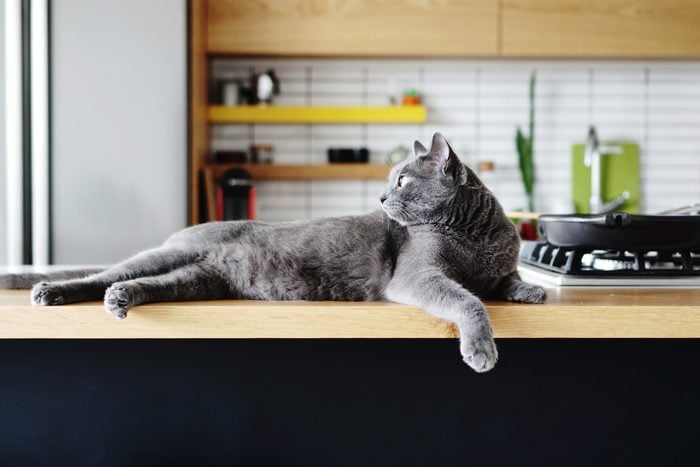5 Simple Ways for Getting Rid of Cat Smell
Updated: Dec. 20, 2023

Cat smells stinking up your home? Here are five DIY ways to get rid of the stink for good.
Lingering cat smells can be a headache for homeowners. Even if residents of the home become so used to the smells they no longer notice, you can bet guests and potential buyers will.
Plus, cat smells can be offensive to cats themselves. Cats mark territory with their urine. And a cat smelling the scent of another cat, particularly one from a different household, may develop behavioral issues such as aggression, agitation or urinating in inappropriate places, such as peeing outside the litter box. If a cat keeps peeing on carpet, it could be because there’s a lingering urine odor in that spot.
That’s why understanding what causes a cat smell to linger, and learning how to get rid of it, can make your home a more pleasant place to live and visit.
On This Page
Why Is Cat Smell So Hard To Get Rid Of?
Cat smell, particularly cat urine, is hard to eliminate because of its chemical makeup.
“Cat urine contains uric acid, along with other compounds such as pheromones, especially if the cat is claiming its territory,” says Bruce Vance, a certified house cleaning technician with Town and Country Cleaning Services. “Common cleaning agents don’t remove the uric acid, which can linger in a home for years.”
Cat urine also contains urea, a different compound created when proteins break down. Urea itself is odorless. But as it ages, it breaks down into ammonia, which has a strong odor. That’s why cat urine tends to smell worse over time.
How cats evolved makes matters worse. “Cats originated from desert animals, so they are very good at conserving water,” says Dr. Chyrle Bonk, a veterinarian. “This makes their urine very concentrated.”
Cat hair, vomit, dander and feces can also cause a home to smell. Your cat’s litter box may be another cause. Keep cat litter clean to reduce odor.
How To Get Rid of Cat Smells
While cat smells new or old can be pesky, it’s possible to remove them. It can be particularly difficult to learn how to get cat pee out of clothes, furniture, carpets and other materials. If the mess is fresh, first blot or wipe away as much of the cat urine, vomit, etc. with a paper towel or old cloth. Then consider one of the following five options. All but the first can be used on any surface.
Vacuuming and washing
Vacuuming can be especially helpful for cat hair or dander smells, Bonk says. If your cat sheds, vacuum your home at least once a week and be sure to empty the vacuum cleaner bag right away so the smell doesn’t linger.
A vacuum that catches cat hair can go a long way toward keeping smelling fresh. Regularly cleaning washer-safe cat beds or cat blankets can also help control smells while getting rid of hair and dander at the same time.
Baking soda
Baking soda, Vance says, neutralizes acidic properties, such as the uric acid in cat pee. Sprinkle baking soda over the affected area and let it sit for 15 to 30 minutes, depending on the severity of the smell. Then wipe or vacuum it away.
Vinegar
Because vinegar is acidic, it can neutralize bacteria in fresh cat pee and alleviate odor, Vance says.
Mix equal parts white or apple cider vinegar and water in a spray bottle. Spray the vinegar cleaning solution on the affected area, whether your floor or furniture. Blot away the solution with a paper towel or old cloth. Repeat until the smell is gone.
Enzymatic cleaners
Enzymatic cleaners, Vance says, are effective because they break down ammonia, sulfur and other compounds in cat urine, vomit and feces. That’s also why they remove old cat smells better than baking soda or vinegar and water.
Follow label instructions for use. Instructions for how to get cat pee out of carpet might differ from getting it out of laundry. In general, thoroughly spray the affected area and let it sit for 15 to 30 minutes. Then blot or scrub away the solution and let it air dry for a few hours.
Hydrogen peroxide
Finally, Vance recommends hydrogen peroxide because it oxidizes the ammonia smell. Pour it directly on the affected area, let it rest for five minutes, then wipe or scrub it away.
For a fresher smell, add a teaspoon of dishwasher detergent to the solution. Be sure to thoroughly remove the product because it can discolor if left sitting too long, especially on fabric or carpet.
Note: To avoid staining, test this method on a spot you can easily cover.
Still Can’t Get Rid of Cat Smell?
Sometimes, you may not know exactly where an old cat smell is coming from. Sprinkling baking soda on several suspected areas, giving your home a good vacuum and cleaning your hardwood floors with vinegar and water may help you find the source.
If these DIY options don’t remove cat smells, or if you can’t find the affected area, you may need to hire a cleaning company.
“In extreme cases where the odor has dispersed through the furnishings and even walls of a room, it may be necessary to bring in a professional to treat the area,” Vance says.
